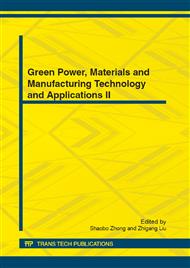[1]
Kamide K. Cellulose and cellulose derivatives: molecular characterization and its applications [M]. Elsevier,2005.
Google Scholar
[2]
Zugenmaier P. Conformation and packing of various crystalline cellulose fibers [J]. Progress in Polymer Science. 2001, 26(9):1341-1417.
DOI: 10.1016/s0079-6700(01)00019-3
Google Scholar
[3]
Qingzheng Cheng, David DeVallance, Jingxin Wang and Siqun Wang. Advanced Cellulosic Nanocomposite Materials [M].
Google Scholar
[4]
Marhöfer R J, Reiling S, Brickmann J. Computer simulations of crystal structures and elastic properties of cellulose[J]. 1996,100(8): 1350-1354.
DOI: 10.1002/bbpc.19961000813
Google Scholar
[5]
Frankland S J V, Harik V M, Odegard G M, et al. The stress–strain behavior of polymer–nanotube composites from molecular dynamics simulation[J]. Composites Science and Technology. 2003, 63(11): 1655-1661.
DOI: 10.1016/s0266-3538(03)00059-9
Google Scholar
[6]
Montès H, Mazeau K, Cavaillé J Y. The mechanical β relaxation in amorphous cellulose [J]. Journal of Non-Crystalline Solids. 1998, 235-237(0) :416-421.
DOI: 10.1016/s0022-3093(98)00600-0
Google Scholar
[7]
Kelley S, Rials T, Glasser W. Relaxation behaviour of the amorphous components of wood [J]. Journal of Materials Science. 1987, 22(2): 617-624.
DOI: 10.1007/bf01160778
Google Scholar
[8]
Chui C, Boyce M C. Monte Carlo Modeling of Amorphous Polymer Deformation: Evolution of Stress with Strain [J]. Macromolecules. 1999, 32(11): 3795-3808.
DOI: 10.1021/ma9815399
Google Scholar
[9]
Chen W, Lickfield G C, Yang C Q. Molecular modeling of cellulose in amorphous state. Part I: model building and plastic deformation study [J]. Polymer. 2004, 45(3): 1063-1071.
DOI: 10.1016/j.polymer.2003.11.020
Google Scholar
[10]
Hossain D, Tschopp M A, Ward D K, et al. Molecular dynamics simulations of deformation mechanisms of amorphous polyethylene[J]. Polymer. 2010, 51(25): 6071-6083.
DOI: 10.1016/j.polymer.2010.10.009
Google Scholar
[11]
Yashiro K, Ito T, Tomita Y. Molecular dynamics simulation of deformation behavior in amorphous polymer: nucleation of chain entanglements and network structure under uniaxial tension [J]. International Journal of Mechanical Sciences. 2003,45(11): 1863-1876.
DOI: 10.1016/j.ijmecsci.2003.11.001
Google Scholar
[12]
Theodorou D N, Suter U W. Detailed molecular structure of a vinyl polymer glass [J]. Macromolecules. 1985,18(7), 1467-1478.
DOI: 10.1021/ma00149a018
Google Scholar
[13]
Plimpton S. Fast parallel algorithms for short-range molecular dynamics [J]. Journal of Computer Physics.1995, 117(1): 1-19.
DOI: 10.1006/jcph.1995.1039
Google Scholar
[14]
van Duin A C T, Dasgupta S, Lorant F, et al. ReaxFF: A Reactive Force Field for Hydrocarbons [J]. The Journal of Physical Chemistry A. 2001, 105(41): 9396-9409.
DOI: 10.1021/jp004368u
Google Scholar
[15]
van Duin A C T, Strachan A, Stewman S, et al. ReaxFFSiO Reactive Force Field for Silicon and Silicon Oxide Systems [J]. The Journal of Physical Chemistry A. 2003, 107(19): 3803-3811.
DOI: 10.1021/jp0276303
Google Scholar
[16]
Simperler A, Kornherr A, Chopra R, et al. Glass Transition Temperature of Glucose, Sucrose, and Trehalose: An Experimental and in Silico Study[J]. The Journal of Physical Chemistry B. 2006, 110(39): 19678-19684.
DOI: 10.1021/jp063134t
Google Scholar


